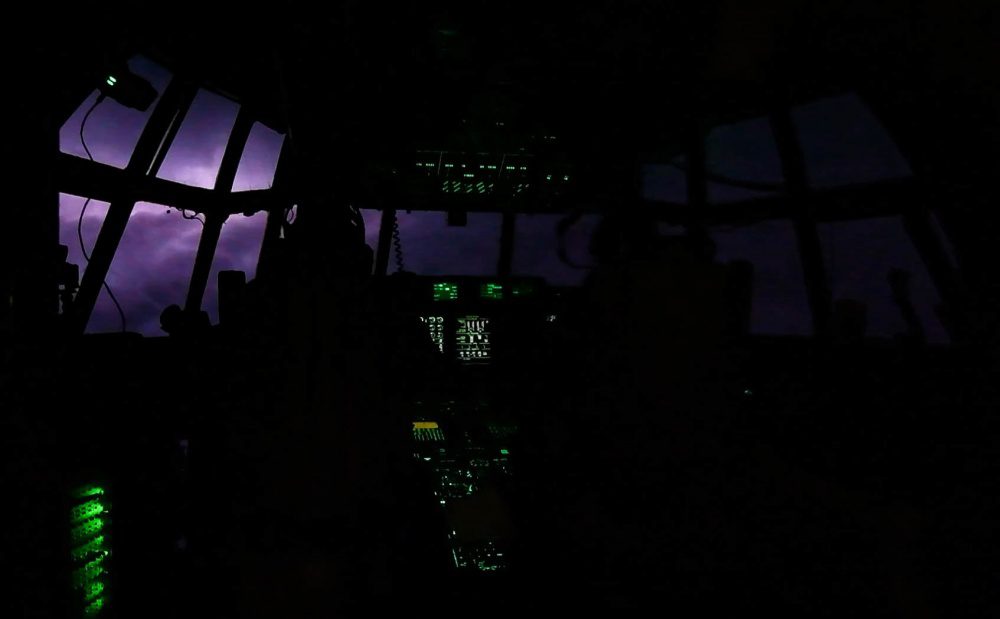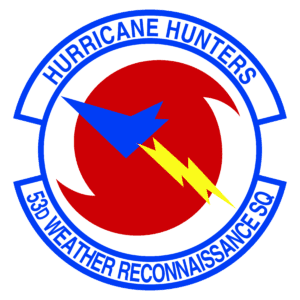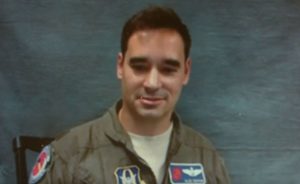Boykin ’05: “Almost Unbelievable Power”

As a WC-130J flies into Hurricane Dorian’s eye, lightning illuminates the surrounding clouds. Photo courtesy U.S. Air Force Staff Sgt. Diana Cossaboom.

As a WC-130J flies into Hurricane Dorian’s eye, lightning illuminates the surrounding clouds. Photo courtesy U.S. Air Force Staff Sgt. Diana Cossaboom.
Everyone is familiar with the usual cycle of seasons: Spring, summer, autumn and winter. Yet, those who live on or close to America’s coasts always have another one in mind: Hurricane season. Lasting from June 1 to Nov. 30, it is the time when meteorological conditions most favor the formation of tropical cyclones in the North Atlantic and Eastern Pacific Oceans.
With tens of millions of people and trillions of dollars of property at risk, forecasting the power, speed and direction of these potentially devastating storms is of immense concern to the federal government. To keep an eye on the areas in which storms form and travel, it operates a network of weather satellites and collects data from surface observations and radar.
Yet, there is another source of data that the National Hurricane Center’s staff depends on: Weather-reconnaissance aircraft. Known as the Hurricane Hunters, the 53rd Weather Reconnaissance Squadron, operated by the U.S. Air Force Reserve, flies specially-equipped WC-130J aircraft that investigate extreme weather disturbances and gather vital information about them, such as wind speed, barometric pressure and, most importantly, position, direction and forward speed.

The unit patch for the 53rd Weather Reconnaissance Squadron. Photo courtesy 403rd Wing, U.S. Air Force Reserve.
One of the men and women who fly the WC-130J aircraft of the 53rd WRS into these systems is Maj. Alex Boykin ’05, who joined the unit in 2017.
Boykin came to VMI on an Air Force scholarship and with a desire to fly. “VMI was one of only two schools that I applied to, the other being the Naval Academy. I grew up around several prominent VMI alumni, including Mory Wood ’79, who was a major influence on me and my decision to apply to and attend the Institute.” As to his dream of being a pilot, Boykin said, “I wanted to fly since I was a young kid, and, I wanted to fly in combat.”
In the Air Force, Boykin has flown the venerable C-130. “To be more precise,” he says, “I have flown seven variants of it, including the MC-130J in which I have the majority of my flight and combat time.”
With more than 1,000 combat hours and multiple combat deployments and decorations from the conflicts in Afghanistan and Iraq, he decided that it was time for a change. About three years ago, he began looking for an Air Force Reserve flying unit that would allow him and his wife to live closer to his wife’s family. Among the units that would allow that was the 53rd WRS based at Keesler Air Force Base in Biloxi, Mississippi. Although the locality fit the bill, what sold Boykin on the unit was what it did, “I was very interested in its weather mission.”

Alex Boykin ’05, taken from a TV interview. Photo courtesy WWBT.
Executing the “weather mission” demands a lot of the squadron’s aircraft and their air and ground crews. Under the National Hurricane Operations Plan, which in part governs “weather reconnaissance,” the 53rd WRS must be available around-the-clock and be able to fly into three storms a day. According to Boykin, the required response time is short. When the unit receives a tasking from the NHC, a plane can launch in as little as 16 hours, which is exceptional for a reserve unit.
Whether flown from the squadron’s home base, its forward Atlantic base in the U.S. Virgin Islands, or its forward Pacific base in Hawaii, a mission can last longer than 12 hours – and that doesn’t count the time spent in preparation. Once in the storm environment the crews execute alpha patterns: “A series of large Xs of varying length on intercardinal headings during which we can pass through the eye of the storm multiple times on a single sortie,” is how Boykin describes it.
Throughout the mission, the aircraft’s aerial weather reconnaissance officer keeps track of meteorological data from various sensors, including dropsondes, devices that are dropped from the plane as it penetrates a storm’s eyewall and outer bands as low as 5,000 feet. The crews will fly the mission until the NHC requirements are met or they “bingo” on fuel.
That need for data doesn’t stop when the sun goes down. So, it’s no surprise that the Hurricane Hunters don’t keep normal office hours. According to Boykin, once a weather system begins to threaten the U.S. or one of our partners, the unit will have aircraft in the storm 24 hours a day. Therefore, missions will routinely launch between midnight and 4:00 a.m. to get the most current information for the NHC’s morning forecast that will air on all the news channels, and which most people will use to do their planning.
What keeps Boykin in the business of hunting hurricanes? “I would say it is what keeps most people in jobs like this: The people and the mission. I like and respect the people with whom I work, and I know our mission is important.”
Asked to elaborate on the second point, he replied, “This year, I witnessed the almost unbelievable power of a Category 5 storm as it approached the Bahamian islands of Abaco and Grand Bahama – and then basically stopped on top of them. As we penetrated the eye wall and flew through the eye multiple times during those two days, it was evident what 200-plus mph winds can do. The data we collect on missions like that markedly improves the accuracy of the NHC’s forecasts,” he continued. “That helps local, state and federal agencies better prepare their responses and, if necessary, order evacuations. The atmosphere is extremely complex, and forecasting these extreme weather events is a highly complicated endeavor, be it a tropical cyclone or a winter storm like Super Storm Sandy. The more accurate the forecasts are, the more people will trust them and the more likely they are to heed warnings and evacuation orders, which in turn will save lives.”
Asked for any parting thoughts, Boykin instead made a request. “The pictures from the Bahamas of the aftermath from Hurricane Dorian show these storms’ immense destructive power. If your local authorities issue an evacuation order for a hurricane – or, for that matter, any other natural disaster, be it a wildfire or a flood – listen to them and get out before you become a statistic or unnecessarily put rescue personnel in danger due to your lack of a plan or your poor judgment.”

The communications officer supports the strategy for all communications, including web content, public relations messages and collateral pieces in order to articulate and promote the mission of the VMI Alumni Agencies and promote philanthropy among varied constituencies.